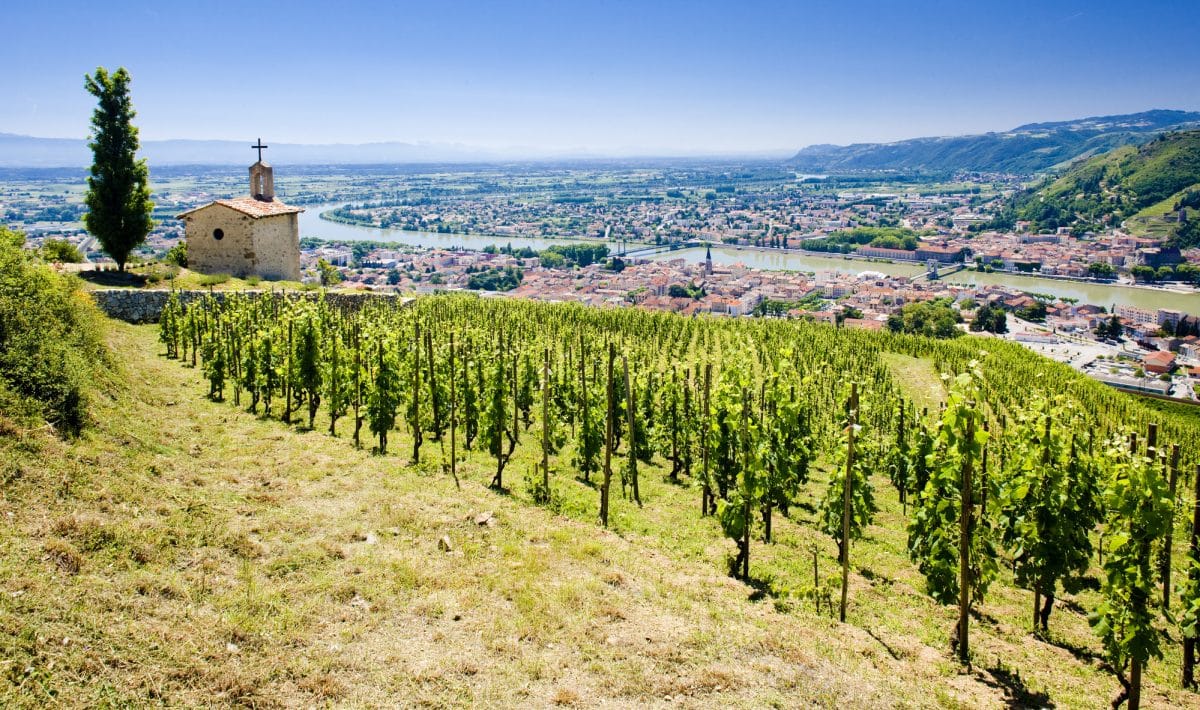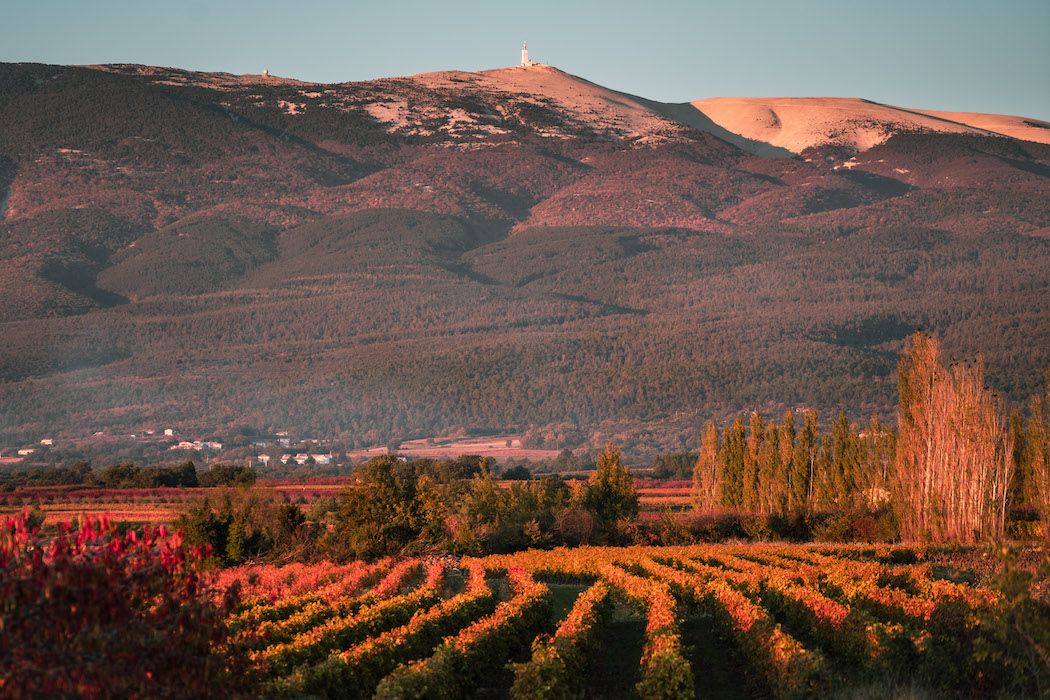The Rhône Valley is the second biggest wine region in France so it’s no surprise that thousands thronged to its annual wine-tasting salon, Découvertes en Vallée du Rhône (DVR). This year there were some 600 producers showing their wines. Before the fair moved north, the action started in the Papal Palace in Avignon with an impressive showcase of southern Rhône wines. This spectacular fortress-cum-palace oozes history from every stone.

The Découvertes en Vallée du Rhône starts in the Papal Palace in Avignon
But today’s concerns were never far away. The Rhône is traditionally known for its great variety of reds from exclusive top-end wines to bulk products. Yet consumer tastes are changing markedly. Heavy reds are fast losing favour, especially with younger drinkers. It’s whites – and rosés – that are on the up.
And there was a further nasty surprise for producers. Half-way through the event we learned that President Trump was to slap punitive tariffs on goods from the EU. The Rhône trade association, Inter Rhône and the DVR organiser has also worked in the US to promote the region. Suddenly, all that looked in jeopardy. “I’m sad,” said one frustrated Condrieu producer.
Still, the mood was far from despondent and Rhône – which is redoubling an emphasis on quality – is determined to lead a fightback. The region’s ambition is to double production of whites by the end of the decade.
The biggest grower of whites is Côtes du Rhône AOC, accounting for nearly 30% of the Rhône Valley’s white wine production. Quality and interest have grown significantly. The six principal grape varieties permitted are Bourboulenc, Clairette, Grenache Blanc, Marsanne, Roussanne and Viognier, withPiquepoul Blanc and Ugni Blanc also allowed.
The blend of local grape varieties gives the whites of the Côtes du Rhône that vital balance of refreshing acidity, aroma and body. The overall diversity of styles is immense, illustrated by the way the wines are categorised by Inter Rhône in three sections: Fresh and Lively, Fruity and Round, Rich and Complex.
White Rhône AOC news

Laudun masterclass with top French sommelier Xavier Thuizat
The Laudun appellation is important for whites, which account for nearly 30% of its wine production. Laudun only became a cru in its own right in 2023 (previously falling under the Côte du Rhône Villages AOC) and is elevating its profile in France and internationally. Last year’s production marks the first vintage under its new name. Laudun has caught the zeitgeist, promoting a contemporary style showcasing its limestone terroir and a fresh and light approach.
Xavier Thuizat, declared Top Sommelier in France 2022 led a Laudun masterclass. He buys for the historic luxury Hôtel De Crillon in Paris and also purchases an astounding volume for Air France (according to my notes, ordering 750,000 bottles a month!). He presented first the Laudun Blanc 2024, Sol et Sens Vignerons des 4 Chemins and then the Laudun Blanc 2024, Château de Bord Maison Brotte. The former has lively apple in the palate and peachy stone fruit on the nose while the latter has agrume and almond on the palate and pear on the nose.
For political reasons, the most well-known of all Rhône appellations, the AOC Châteauneuf-du-Pape, is not a member of Inter Rhône. Despite this, a handful of its producers attended the fair. Châteauneuf-du-Pape produces just 7% of white wines so it’s a bit late to the go-white party. But the overall quality can’t be disputed.

Pierre Amadieu at the Découvertes en Vallée du Rhône 2025
Renowned Gigondas (adding white wines to the AOC in 2022) is even more of a laggard – a miniscule 1% of its area is planted with white varietals but this is set to rise. Certainly, releases of white made for the first time in 2023 look pretty promising.
Some are presented by Pierre Amadieu, an important producer in Gigondas, and a co-president of the appellation, owning around 10% of the vineyard area. First was the 2023 Domaine Grand Romane Gigondas Blanc which is 100% Clairette. It was deliciously complex and aromatic with some saline notes on the finish. Similarly, noteworthy was the 2024 Romane Machotte Gigondas Blanc. Composed of 70% Clairette, 25% Marsanne, Roussanne and 5% Viognier, this embodies the aromatic harmony of the different grape varieties and is a powerful expression – in a white blend – of the Gigondas terroirs. It has freshness and structure with delicate aromas of citrus.
There’s still less consumer brand recognition for Lirac, although this was the first Cru to allow production of all three colour categories (red, white and rosé). Seen by some as the AOC of the future, over 56% of the producers are organic and the figure is increasing.
We tasted a range of Liracs from fresh and light to intense. The best boast finesse and elegance and with four to five years of bottling you get the full sense of what they are capable of. Lirac Blanc 2016, Casta Diva, Domaine Maby (Viognier 60% and Grenache 40%)shows Lirac’s ageing potential. There are powerful aromas of apricot, peach, pear and white flowers.
“Ventoux is a rising star of the Rhône to watch,” says Alistair Cooper MW, Rhône expert and also a masterclass presenter at the DVR. “The time is right to discover this previously overlooked, up and coming area – it is perfect for people who like to discover new things before they are well known.” White Cairannes, led by Clairette are also getting attention and demand is on the up, so plantings may increase from the current 7%.
During the fair, the news emerged that Rasteau on the left bank and Vinsobres on the right are both petitioning to add white wines to their appellations. But, we are told to be patient – applications can be a lengthy process!
Low alcohol sparkling

Emmanuel Poulet shows his Clairette de Die Tradition
It was time to head north. Up in the mountains 30 miles east of the Rhône Valley, vineyards stand rather remote in their elevated position. A surprise discovery was the sparkling wine from the appellation of Die. Interest and demand is growing in Clairette de Die (Muscat Blanc 75%, Clairette Blanche 25%) as it is naturally low in alcohol (c.8% ABV). Clairette de Die is lightly sweet and made by a unique method called Méthode Dioise Ancestrale. Fermentation begins slowly in vats at cool temperatures but is completed in the bottle, trapping the carbon dioxide. There is also AOC Crémant de Die (Clairette Blanche, Aligote and Muscat Blanc) a dry sparkling.
Whites in the Northern Rhône

M Chapoutier, AOC Hermitage, Chante-Alouette 2018 Methuselah
In Mercurol we meet a host of northern Rhône producers including Crozes-Hermitage, Saint-Péray and Saint-Joseph and it’s great to see the new association ‘La Nouvelle Garde de Crozes-Hermitage’ promoting the younger generation in wine.
One evening we were indulged insanely by Michel Chapoutier, the prominent producer in the northern Rhône region. He threw a party in his Maison in Tain l’Hermitage. Reds of the sort that earn tasting scores of 95 to 100, such as L’Ermite and Le Meal, were flowing liberally. Methuselahs, too many to count, were uncorked. And among the whites was also a real treat, a delicious 100% Rousanne white wine, Chante-Alouette. Biodynamic certified, this has a powerful nose of tropical and stone fruits, lemon, honey, butter, ginger spice and sage.

Christine Vernay and daughter Emma at Découvertes en Vallée du Rhône 2025
For the final day, the wine fair moved up again along the Rhône Valley to Ampuis. No discussion of white Rhône would be complete, of course, without a mention of Condrieu – long the most sought-after white Rhône wine, produced solely from Viognier. Here too the buzz words are “freshness and light” as consumer styles change from the heavier, more intense wines to wines more suited to an aperitif or fine dining. Two of the notable producers who have helped promote Condrieu are Domaine Georges Vernay and Caves Yves Cuilleron and we discover smaller emerging producers such as Vinobles Chirat too.

Yves Cuilleron
The Rhône Valley is upbeat
So, overall, the mood in the Rhône is upbeat. Above all, the region’s producers have a thirst for quality and the 2024 harvest was top quality despite low yields. And, in addition to the buzzing fair, more contemporary, youthful campaigns are planned to ensure the Rhône wines gain headspace with younger generations.
The President of the Inter Rhône marketing board Phillippe Pellaton is quick to reassure: “We are not turning our back on red. The Rhône Valley is not literally turning white, but we do recognise as consumer tastes move away to lighter wines, it is an important market for the region.”







































